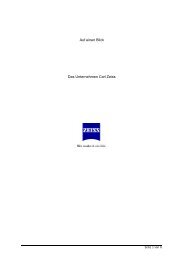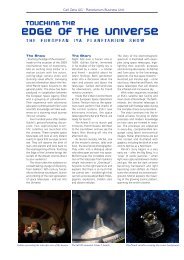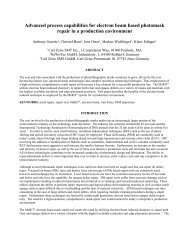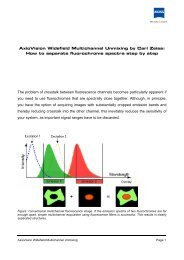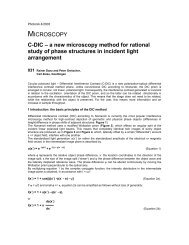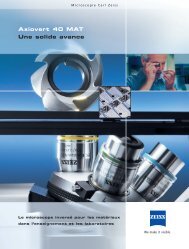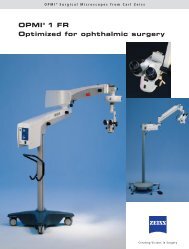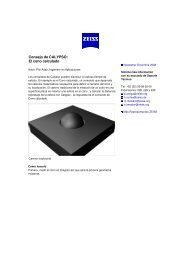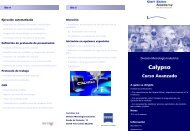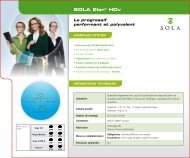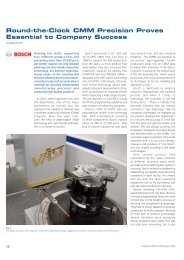ATLAS Corneal Topography System - Carl Zeiss SMT
ATLAS Corneal Topography System - Carl Zeiss SMT
ATLAS Corneal Topography System - Carl Zeiss SMT
You also want an ePaper? Increase the reach of your titles
YUMPU automatically turns print PDFs into web optimized ePapers that Google loves.
Superior <strong>Topography</strong><br />
Performance and Efficiency<br />
The <strong>ATLAS</strong> <strong>System</strong> has been proven to deliver the clinical accuracy and workflow efficiency that your<br />
practice requires. The all-in-one system combines a suite of unique technologies that is simple for virtually<br />
any operator to use. The result is a new level of confidence in every exam and for every patient.<br />
Placido Rings<br />
Cone of<br />
Focus<br />
<strong>Corneal</strong><br />
Surface<br />
Triangulation with the Cone-of-Focus, Placido rings, and<br />
corneal surface delivers superior accuracy<br />
Placido Rings<br />
Cone of<br />
Focus<br />
<strong>Corneal</strong><br />
Surface<br />
SmartCapture makes image acquisition easy<br />
1- Data on file<br />
2- Except for PathFinder II <strong>Corneal</strong> Analysis Software<br />
Proven Placido Disk Technology<br />
• Patented Cone-of-Focus Alignment <strong>System</strong> and<br />
Arc-Step Algorithm deliver sub-micron elevation<br />
accuracy 1<br />
• 22-ring Placido disk optimized to avoid ring<br />
crossover, which means reliable results for a wide<br />
range of patients<br />
• Long, comfortable 70 mm working distance<br />
minimizes focusing error found in “small cone”<br />
systems<br />
SmartCapture Image Analysis Helps<br />
Your Staff Get it Right the First Time<br />
• SmartCapture analyzes 15 digital images per<br />
second during alignment and automatically<br />
selects the highest quality image<br />
• Next-generation image processing provides more<br />
repeatable, reliable results, even in difficult cases<br />
• Less dependence on operator technique means<br />
greater efficiency and fewer repeat exams<br />
Workflow Flexibility with<br />
Review Software<br />
• Dynamic remote access to all your corneal<br />
topography exam data and patient education<br />
tools, such as corneal wavefront simulation<br />
• Equivalent analysis functionality as the<br />
<strong>ATLAS</strong> Model 9000 2<br />
• Compatible with <strong>ATLAS</strong> Models 993 and 995 2<br />
<strong>ATLAS</strong> Model 9000 <strong>ATLAS</strong> <strong>Corneal</strong> <strong>Topography</strong> <strong>System</strong><br />
Technical Specifications<br />
Working Distance<br />
Field of View<br />
Placido Rings<br />
Illumination Source<br />
Optics<br />
Curvature Measurement Range<br />
Accuracy<br />
Reproducibility<br />
HVID (white to white) Measurement Range<br />
Resolution<br />
Pupillometry Acquired Images<br />
Measurement Range<br />
Resolution<br />
Views<br />
Presentation Displays<br />
Optional Software/Third Party Software<br />
Computer<br />
Dimensions/Weight<br />
(Instrument only)<br />
Electrical<br />
NOTE: All technical specifications are subject to change without notice.<br />
Windows is a registered trademark of Microsoft Corporation. Pentium is a registered trademark of Intel Corporation.<br />
<strong>Carl</strong> <strong>Zeiss</strong> Meditec AG<br />
Goeschwitzer Str. 51 – 52<br />
07745 Jena<br />
GERMANY<br />
Phone: +49 36 41 22 03 33<br />
Fax: +49 36 41 22 01 12<br />
info@meditec.zeiss.com<br />
www.meditec.zeiss.com<br />
70 mm (2.76 in)<br />
17 mm X 14.5 mm (0.67 x 0,57 in)<br />
22 (18 superiorly, 22 inferiorly)<br />
Non-visible infrared (950 nm) LED<br />
Digital CMOS camera with 1280x1024 pixel resolution<br />
15 to 95 D (3.5 to 22.5 mm)<br />
± 0.05 D (± 0.01 mm) 8<br />
± 0.10 D (± 0.02 mm) 8<br />
10.0 to 14.0 mm (0.39 x 0.55 in)<br />
0.1 mm<br />
Scotopic and photopic (700 nm)<br />
0.5 to 11.0 mm<br />
0.1 mm<br />
• Axial Curvature<br />
• Tangential Curvature<br />
• Elevation (Best-Fit Sphere)<br />
• Irregularity (Best-Fit Ellipsoid)<br />
• Videokeratoscopic (Rings, Scotopic, Photopic)<br />
• Keratometry<br />
• Refractive Power<br />
• Mean Curvature<br />
• <strong>Corneal</strong> Wavefront<br />
• Image Simulation<br />
• Point Spread Function (PSF)<br />
• Modulation Transfer Function (MTF)<br />
• Single View<br />
• Overview<br />
• OD/OS Comparison<br />
• Difference<br />
• Trend with Time, Trend Analysis<br />
• Custom<br />
• PathFinder II <strong>Corneal</strong> Analysis Software<br />
• MasterFit II Contact Lens Software<br />
• <strong>ATLAS</strong> Review Software<br />
• DICOM Gateway<br />
• Wave Contact Lens Software<br />
• Windows ® XP Professional<br />
• Pentium ® M Processor<br />
• Internal storage: up to 35,000 exams<br />
• CD-RW/DVD-ROM<br />
• 3 Ethernet, 2 USB 2.0 ports<br />
• Integrated 12.1” color flat panel display<br />
• 52 L x 37 W x 50 H (cm) (20.74 x 14.57 x 19.69 in)<br />
• 39 lbs. (17.7 kg)<br />
• 100-240V~: 50/60Hz, 2-1A<br />
8- To one standard deviation on a properly calibrated 42.51 D (7.94 mm) test object.<br />
<strong>Carl</strong> <strong>Zeiss</strong> Meditec Inc.<br />
5160 Hacienda Drive<br />
Dublin, CA 94568<br />
USA<br />
Phone: +1 925 557 41 00<br />
Fax: +1 925 557 41 01<br />
info@meditec.zeiss.com<br />
www.meditec.zeiss.com<br />
Publication No: 000000-1836-953 ATL.1587 Rev B<br />
The contents of the brochure may differ from the current status of approval of the product in your country. Please contact our regional representative for more information.<br />
Subject to change in design and scope of delivery and as a result of ongoing technical development. Printed on elemental chlorine-free bleached paper. P U B L I C I S II/2010.<br />
© 2009 by <strong>Carl</strong> <strong>Zeiss</strong> Meditec AG. All copyrights reserved.<br />
Simply accurate for maximum productivity
Take your practice to the next level<br />
With more than 15 years experience in corneal topography, <strong>Carl</strong> <strong>Zeiss</strong> Meditec now offers the next generation<br />
of the <strong>ATLAS</strong> ® Model 9000. The <strong>ATLAS</strong> <strong>System</strong> delivers the clinical accuracy essential to today’s eye care practice,<br />
in a powerful and easy to use platform. With applications including contact lens fitting, pathology detection<br />
and management, and selection of aspheric IOLs, the new <strong>ATLAS</strong> <strong>System</strong> is the right choice for reliable realworld<br />
results, every time, from virtually any operator.<br />
Superior Performance Designed for<br />
How You Practice<br />
• Compact, all-in-one system, now easier to use and<br />
more efficient<br />
• Improved repeatability and reliability<br />
• Compatible with your existing <strong>ATLAS</strong> data<br />
• Compatible with Visante ® omni to generate<br />
posterior topography<br />
Elevate Your Practice with <strong>ATLAS</strong><br />
The next-generation <strong>ATLAS</strong> <strong>System</strong> provides new<br />
tools and superior data acquisition and analysis<br />
to set your practice apart. From increasing<br />
patient satisfaction, to gaining greater clinical<br />
insight, to improving overall workflow, the <strong>ATLAS</strong><br />
<strong>System</strong> can take your practice to new heights.<br />
Color Scale<br />
Customize colors and<br />
scales for detailed corneal<br />
assessments<br />
<strong>Topography</strong> Map<br />
Display as curvature,<br />
elevation, corneal<br />
wavefront, even image<br />
simulations. Landmarks<br />
such as corneal apex ,<br />
pupil contour, and pupil<br />
center help explain the<br />
impact on visual acuity<br />
Intuitive Analysis and Reporting<br />
Axial map reveals a displaced corneal apex and inferior steepening, which standard keratometry at 3mm would have missed.<br />
Novel Applications for Cataract Care<br />
<strong>Corneal</strong> Wavefront Analysis is a valuable tool guiding you to the suitable technologies which will<br />
correct visual distortion. The <strong>ATLAS</strong> provides all the key topographical information needed to<br />
enhance IOL power calculation and IOL selection as well as set appropriate patient expectations.<br />
3- M. Jeandervin and J. Barr, “Comparison of repeat videokeratography: repeatability<br />
and accuracy,” Optom. Vis. Sci. 75, 663–669 (1998)<br />
4- Evaluating data acquisition and smoothing functions of currently available<br />
videokeratoscopes. J Cataract Refract Surg 22 (1996);22:421-426<br />
• Educate patients about higher-order<br />
aberrations and simulate visual acuity<br />
with various pupil sizes<br />
• Assess corneal refraction with image<br />
simulation and point spread function<br />
• Optimize aspheric IOL selection with<br />
corneal spherical aberration, Z(4,0),<br />
based on Placido disk technology 3,4<br />
• Established IOL power formulas for<br />
myopic and hyperopic LASIK/PRK and RK 5,6<br />
• Perioperative astigmatism management<br />
5- iol.ascrs.org (accessed 10/01/09)<br />
6- http://doctor-hill.com/iol-main/keratorefractive.htm (accessed 10/01/09)<br />
Data<br />
Automatically display<br />
preferred parameters such<br />
as simulated keratometry,<br />
shape factor, eccentricity,<br />
and HVID (white to white)<br />
Cursor Value<br />
Obtain the exact value at<br />
any point on the map<br />
7- Data on file<br />
PathFinder II <strong>Corneal</strong> Analysis Software<br />
Advancing traditional topography. PathFinder II <strong>Corneal</strong> Analysis Software is a comprehensive,<br />
easy to understand, and reliable anterior topographic screening module to assist with refractive<br />
surgery screening and to help identify abnormal corneal conditions.<br />
1.<br />
PathFinder II provides probabilities<br />
for 5 different corneal conditions by<br />
comparing topography exams to an<br />
extensive clinical database. Validation<br />
of PathFinder II with an independent<br />
data set demonstrated greater than<br />
90% sensitivity, specificity, and accuracy<br />
in detecting normal versus abnormal<br />
corneas 7 .<br />
2.<br />
Color-coding of PathFinder II parameters<br />
quickly indicates which parameters<br />
are beyond normal limits and may<br />
contribute to specific classifications.<br />
MasterFit II Contact Lens Software<br />
3.<br />
In this example, traditional axial<br />
curvature does not highlight the nature<br />
of the cornea as compared to mean<br />
curvature.<br />
4.<br />
3-dimensional mean curvature analysis<br />
eliminates corneal astigmatism to reveal<br />
underlying local curvature irregularities.<br />
The size and location of corneal<br />
irregularities, especially in the periphery,<br />
are better highlighted.<br />
Direct your fitting success. MasterFit II Contact Lens Software helps streamline fitting gas<br />
permeable (GP) lenses and guides you through challenging-to-fit patients. Simulated fluorescein<br />
patterns and tear film thickness profiles promote effective lens design to minimize chair-time and<br />
improve patient satisfaction.<br />
• Simulate fluorescein patterns for custom and<br />
stock lenses, including spherical, toric, and<br />
aspheric designs<br />
• Automatically design lenses to your preferences<br />
by customizing fitting options such as desired<br />
tear film clearance<br />
• Improve trial lens fitting efficiency by adjusting<br />
lens parameters, such as peripheral curves, and<br />
simulating lens movement to compensate for<br />
lens-to-cornea relationship<br />
• Email lens design and topography exam to your<br />
lab for efficient ordering and fulfillment



